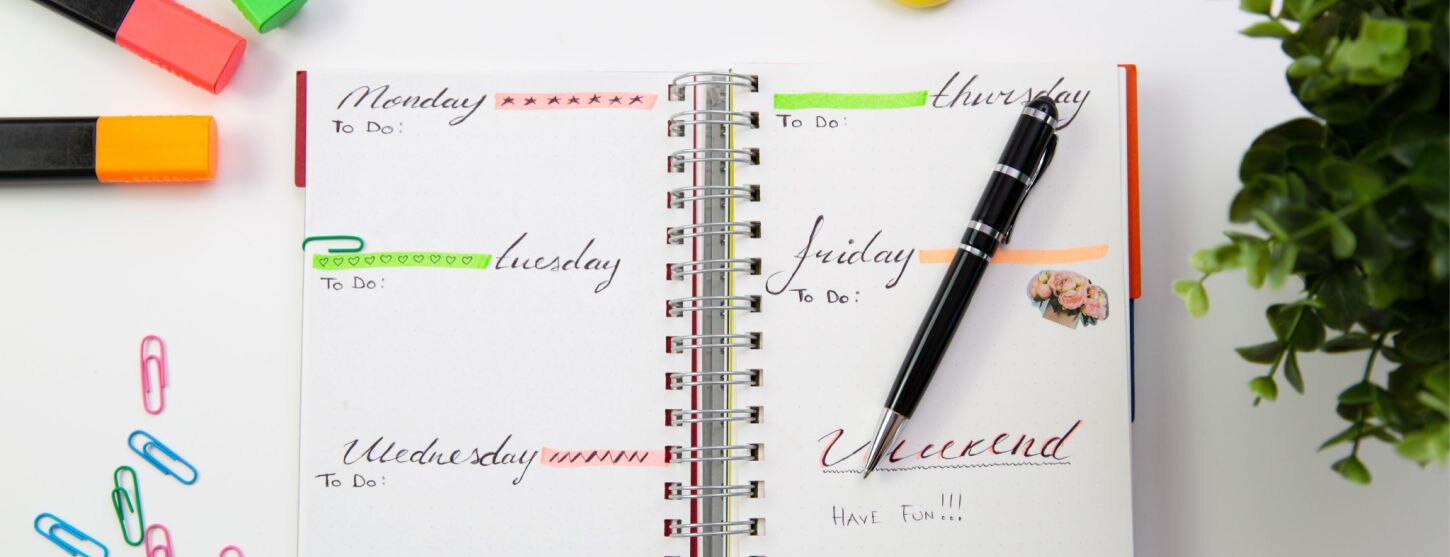How to start a bullet journal (& make it work for you)

There’s not much more satisfying than a brand-new notebook.
For some, those blank pages might be full of promise… But, for others, it might be a little too intimidating to put pen to paper. Why ruin perfection?
Bullet journalling is the answer to both! It’s a totally customisable way to see your plans at a glance (and get decorating).
It’s perfect for tracking your health and wellness habits, ideal if you’re setting goals for the year ahead.
You make the rules and you decide how much time to put into your journal - so there’s no pressure.
Skip to:
Why should I try a bullet journal?
Unlike calendars and planners, you’re not bound by the days and months. You can use as much or as little of your journal on the things that matter to you.
Say you have a busy period coming up - why cram it all onto one page?
It also means that you don’t need a stack of separate planners.
The flexibility of a bullet journal really can’t be overstated: in one book, you can have it all.
What could I use a bullet journal for?
The possibilities really are endless. But here are a few bullet journalling ideas to get you started:
- Planning your daily, weekly, or monthly routine
- Tracking your exercise
- Tracking your wellbeing
- Meal planning
- Budgeting
- Writing to-do lists
- Favourites (think books, TV shows, or music)
- Tracking your sleep
- Tracking your period, contraception, or family planning
- Tracking habits (whether you’ve taken your vitamins, for example)
- Planning or documenting your travels
- Setting personal goals
Is bullet journalling good for my wellbeing?
If you’re feeling overwhelmed with tasks, bullet journalling can help break them down into smaller, more manageable steps.
Rather than pages and pages of writing, bullet journals use simple symbols and colour codes to identify whether you’re on track.
Taking just a few minutes a day to plan your routine - or doodle, colour, or scrapbook on the pages - can be a calming outlet.
What do I need to start a bullet journal?
Just a notebook and paper! That’s the beauty of it.
However, if you like to decorate, there’s no end of ways you can spruce up your journal. You might use:
- Coloured pens, pencils, and highlighters
- Stickers or washi tape
- Photos
- Paints
- Stamps and stencils
- Textured paper or material
- Dried flowers
to decorate your pages.
You might want to: track your exercise…
Now we’re onto the planning.
Tracking your exercise can help you better understand your fitness and your body.
You might want to track your progress or workout patterns. Or, maybe you want to hold yourself accountable.
Try colour-coding the types of exercise you’re doing to ensure you’re paying equal attention to everything.
You could colour in boxes, add stickers, or draw faces to show how you felt at the beginning and end of your workout.
Even better, do both and you’ll slowly document which exercise routines make you feel your best.
How to keep a food diary
1
Understand your habits
Keeping tabs on your diet could help you better understand how it intertwines with the rest of your life.
Are you eating a less balanced diet on the days where you’ve slept less? Do you skip breakfast before a certain meeting?
You might not notice these patterns until they’re down on paper, and they might help predict and prevent moments where you feel unmotivated.
It might also hint towards any food sensitivities you may have.
2
Plan your meals
Meal planning is another way to feel organised for the week ahead. You’re far less likely to cave on an impulse if you know there are fresh ingredients waiting at home.
Alternatively, it might show you that it’s okay to say yes! Having your shopping list and your budget side-by-side could help you decide when it’s a good time to treat yourself.
3
Manage your goals
If you’re trying to lose weight, gain weight, or build muscle, tracking your meals could be a valuable record.
One study of almost 1700 participants trying to lose weight found that those who kept daily food records lost twice as much as those who didn’t.1
Understanding how your diet fits in with your life could help you curb unwanted habits or help you reach milestones faster.
However, know that sticking to an extremely strict food or calorie goal, or obsessively documenting your intake, is not a sign of a healthy diet.
If you’re worried your thoughts about food are becoming hard to control, please speak to your GP immediately.
The Happy Pear Twins: Easy healthy habits for life
The Happy Pear Twins: Easy healthy habits for life
The Happy Pear Twins, Stephen and David Flynn, talk to Gemma about their journey running a plant-based business and what they’ve learnt along the way.


Track your mood
Some people like to colour-code their moods or draw faces to represent each day.
Like other bullet journalling habits, it can help to put other aspects of your behaviour into perspective.
Do you feel happier when you’ve been outside? Are you more anxious when your period’s due?
You might not be able to change some patterns, but understanding them may help you make small tweaks or be kinder to yourself in difficult times.
As with any type of bullet journalling, get creative! You’ll find people sharing their bullet journals online (TikTok’s easy to scroll for designs you like).
Getting creative might be a way to help your mood, too. Doodle to calm your mind, or write a diary entry.
One study found that, amongst participants with major depressive disorder, writing daily about their feelings decreased levels of depression.²
The final say
The beauty of a bullet journal is its versatility. No matter how busy you are, how creative or minimal you want your journal to be - it’s down to you.
Bullet journalling can:
- Help you form a clear picture of your daily, weekly, or yearly habits
- Save you from keeping multiple planners
- Help you stay motivated for your goals
- Keep track of your mood, exercise, diet, and more
- Be more personalised and efficient
- Give you total creative freedom
Looking to kickstart your wellness? Check out our Ready. Reset. Go! Hub to hear from our experts and build healthy habits for life.
The advice in this article is for information only and should not replace medical care. Please check with your GP or healthcare professional before trying any supplements, treatments or remedies. Food supplements must not be used as a substitute for a varied and balanced diet and a healthy lifestyle.
Last updated: 7 September 2022



